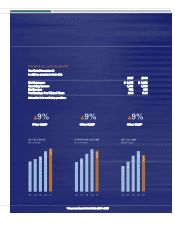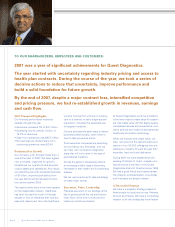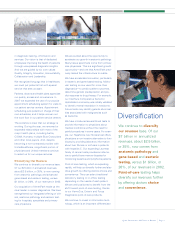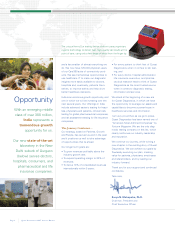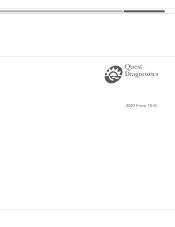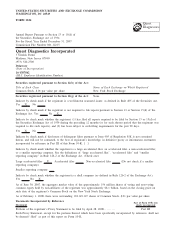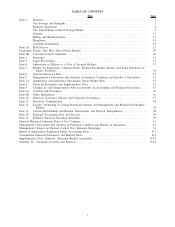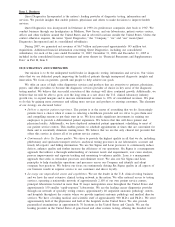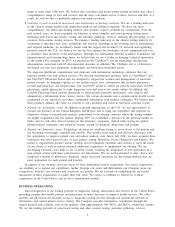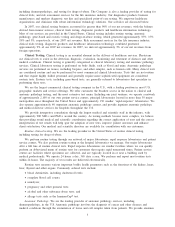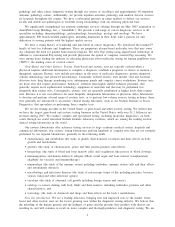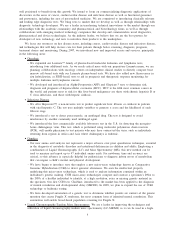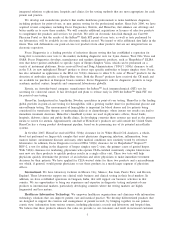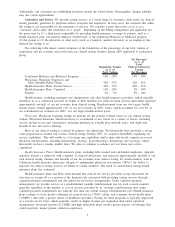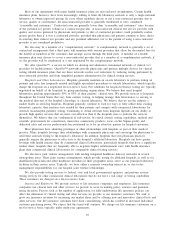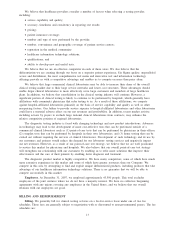Quest Diagnostics 2007 Annual Report Download - page 12
Download and view the complete annual report
Please find page 12 of the 2007 Quest Diagnostics annual report below. You can navigate through the pages in the report by either clicking on the pages listed below, or by using the keyword search tool below to find specific information within the annual report.including dermatopathology, and testing for drugs-of-abuse. The Company is also a leading provider of testing for
clinical trials, and risk assessment services for the life insurance industry. Our diagnostics products business
manufactures and markets diagnostic test kits and specialized point-of-care testing. We empower healthcare
organizations and clinicians with robust information technology solutions. Our activities are discussed below.
In 2007, our clinical testing business accounted for greater than 90% of our net revenues, with the balance
derived from insurer services, clinical trials testing, diagnostic products and healthcare information technology.
Most of our services are provided in the United States. Clinical testing includes routine testing, anatomic
pathology, gene-based and esoteric testing and drugs-of-abuse testing, which generated approximately 55%, 15%,
18% and 3%, respectively, of our 2007 net revenues. Risk assessment services for the life insurance industry,
clinical trials testing, diagnostic products and healthcare information technology combined generated
approximately 9% of our 2007 net revenues. In 2007, we derived approximately 3% of our net revenues from
foreign operations.
Clinical Testing. Clinical testing is an essential element in the delivery of healthcare services. Physicians
use clinical tests to assist in the detection, diagnosis, evaluation, monitoring and treatment of diseases and other
medical conditions. Clinical testing is generally categorized as clinical laboratory testing and anatomic pathology
services. Clinical laboratory testing is performed on body fluids, such as blood and urine. Anatomic pathology
services are performed on tissues, including biopsies, and other samples, such as human cells. Many clinical tests
are considered routine and can be performed by most commercial clinical laboratories. Tests that are not routine
and that require highly skilled personnel and generally require more sophisticated equipment are considered
esoteric tests. Esoteric tests, including gene-based tests, are generally referred to laboratories that specialize in
performing those tests.
We are the largest commercial clinical testing company in the U.S., with a leading position in most U.S.
geographic markets and service offerings. We offer customers the broadest access in the nation to clinical and
anatomic pathology testing, and the most extensive test menu. Including our joint ventures, we operate a network
of approximately 2,100 of our own patient service centers, principal laboratories located in more than 30 major
metropolitan areas throughout the United States and approximately 150 smaller “rapid-response” laboratories. We
also operate approximately 40 outpatient anatomic pathology centers, and provide inpatient anatomic pathology
and medical director services for hospitals throughout the U.S.
We provide interpretive consultation through the largest medical and scientific staff in the industry, with
approximately 900 M.D.s and Ph.D.s around the country. As testing methods become more complex, we believe
that providing sound medical and scientific consultation regarding the correct application of tests and the correct
interpretation of test results will help spur the adoption of new tests, improve patient outcomes and enhance
client satisfaction. Our medical and scientific directors are available for consultation with our customers.
Routine clinical testing. We are the leading provider in the United States of routine clinical testing,
including testing for drugs-of-abuse.
We perform routine testing through our network of major laboratories, rapid response laboratories and patient
service centers. We also perform routine testing at the hospital laboratories we manage. Our major laboratories
offer a full line of routine clinical tests. Rapid response laboratories are smaller facilities where we can quickly
perform an abbreviated menu of routine tests for customers that require rapid turnaround times. Patient service
centers are facilities where specimens are collected, and are typically located in or near a building used by
medical professionals. We operate 24 hours a day, 365 days a year. We perform and report most routine tests
within 24 hours. The majority of test results are delivered electronically.
Routine tests measure various important bodily health parameters such as the functions of the kidney, heart,
liver, thyroid and other organs. Commonly ordered tests include:
•blood chemistries, including cholesterol levels;
•complete blood cell counts;
•urinalyses;
•pregnancy and other prenatal tests;
•alcohol and other substance-abuse tests; and
•allergy tests such as the ImmunoCap威test.
Anatomic Pathology. We are the leading provider of anatomic pathology services, including
dermatopathology, in the U.S. Anatomic pathology involves the diagnosis of cancer and other diseases and
medical conditions through the examination of tissue and cell samples taken from patients. We provide anatomic
3


